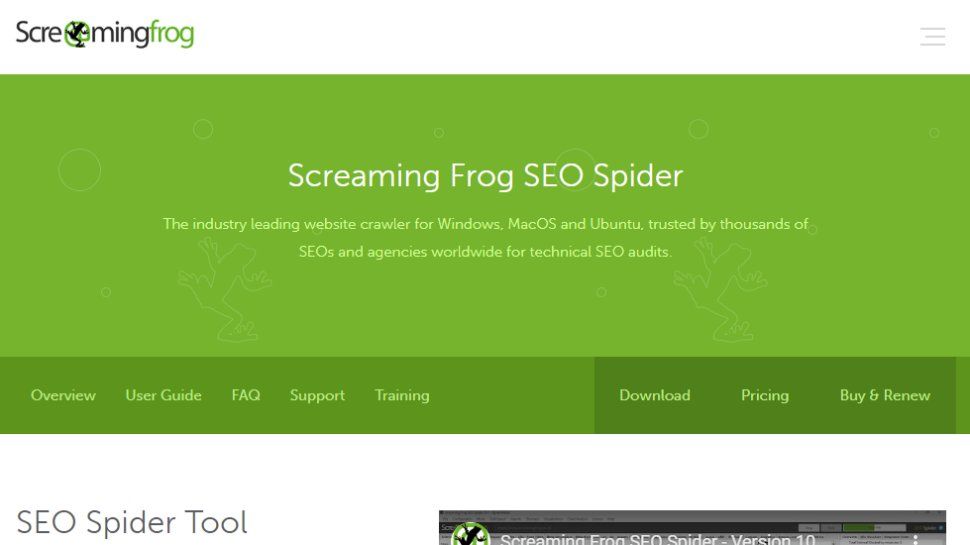TechRadar Verdict
It might confuse beginners but experts are sure to appreciate SEO Spider’s advanced page crawling and site analysis tools.
Pros
- +
Extensive crawling capabilities
- +
Advanced features like JavaScript rendering and custom extraction
- +
Vast integration with Google Analytics and other SEO tools
- +
Customizable reports and data filtering
- +
Bulk purchase discounts for teams
- +
Regular updates with new features
Cons
- -
Steep learning curve for beginners
- -
Paid version may be expensive for individual users
- -
Limited cloud functionality compared to some competitors
Why you can trust TechRadar
Screaming Frog SEO Spider is designed to crawl websites and gather crucial SEO data efficiently. This powerful software simulates how search engines crawl a site and lets you identify key SEO elements that impact website visibility and performance. It further enables the analysis of meta tags, response codes, keyword elements, and much more. Whether it's finding broken links, generating XML sitemaps, or analyzing page titles and meta descriptions, Screaming Frog offers a detailed insight into the website's architecture from an SEO perspective.
Ideal for SEO experts and digital marketers, Screaming Frog is a critical tool for enhancing website searchability and performance. In this review, we will be covering the detailed features, specifications, and offerings of Screaming Frog SEO Spider. From its advanced crawling capabilities to its integration options and reporting features, we will explore how this tool can be leveraged to conduct comprehensive SEO audits, improve website performance, and ultimately drive better search engine rankings.
Screaming Frog: Plans and pricing
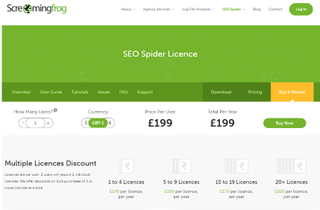
The Free Plan is ideal for small-scale SEO tasks that allow up to 500 URL crawls. It includes basic features like finding broken links, errors, redirects, analyzing page titles, meta data, and generating XML sitemaps. This plan is a great starting point for beginners or small websites.
Priced at £199 /year per license, the Paid Plan offers unlimited URL crawls, subject to available memory and storage. It builds upon the Free Plan with advanced features such as JavaScript rendering for crawling complex websites, custom extraction using CSS Path, XPath, or regex, and integration with Google Analytics, Search Console, and PageSpeed Insights for deeper insights. This plan also includes AMP crawling and validation, structured data analysis, spelling and grammar checks, and the ability to crawl password-protected areas. It's designed for SEO professionals and larger websites needing comprehensive analysis and reporting tools.
Licenses are individual, meaning each user needs a separate one. Screaming Frog offers discounts for bulk purchases, making it cost-effective for teams. The licenses are valid for one year, requiring renewal thereafter. The Paid Plan is particularly beneficial for agencies and larger teams due to its advanced features and scalability.
- We've featured the best SEO tools.
Screaming Frog: Features
Website Crawling and Analysis
Why you can trust TechRadar
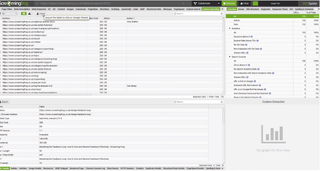
Screaming Frog SEO Spider stands out for its ability to efficiently crawl websites of any size, from small blogs to large e-commerce sites, and provides real-time analysis of your results. This feature is crucial for identifying broken links, server errors, redirects, and security vulnerabilities, thus ensuring the site’s integrity and performance. The tool goes beyond simple error detection and offers deep insights into page titles and metadata that help spot issues, such as duplicate content or poorly optimized tags. Additionally, Screaming Frog extracts specific site data using CSS Path, XPath, or regex. This comprehensive approach to website crawling and analysis lets you pinpoint and address issues efficiently and further optimizes the site for both search engines and users.
SEO Auditing and Optimization
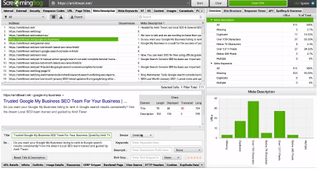
We found that Screaming Frog’s auditing capabilities are equally robust and focus on redirects, robots.txt, and meta-robots directives, among other elements. It can audit temporary and permanent redirects and identify complex redirect chains and loops that can harm search engine visibility and user experience. Screaming Frog also reviews robots.txt, meta robots, or X-Robots-Tag directives and delivers insights into how search engines are directed to crawl and index pages or not. This includes identifying pages blocked from indexing, which could inadvertently hide valuable content from search engines. Another key feature is the validation of Accelerated Mobile Pages (AMP) which makes sure that these pages are free from issues and optimized for performance in mobile search results.
Integration with Google Services
Screaming Frog SEO Spider boosts its capabilities through integration with various Google services, including Google Analytics, Google Search Console, and PageSpeed Insights. This synergy improves the crawl data with crucial user behavior insights, search query data, and vital performance metrics. By combining these datasets, the tool allows for a holistic analysis that spans visibility, speed, and usability. This integration helps SEO professionals access a comprehensive overview of how users interact with their site, identify performance bottlenecks, and understand the site's presence in search results, all within a single platform. This feature underscores the importance of leveraging Google's vast data resources to inform and refine SEO strategies.
Content and Structure Analysis
If you wish to explore the structural aspects of your site, Screaming Frog offers powerful tools for site architecture analysis. It provides detailed visualizations of a site's architecture, internal linking patterns, and URL structure, making assessing and optimizing the site hierarchy easier. These visual tools help in identifying areas for improvement in site navigation, deliver a seamless user experience, and facilitate search engines' understanding of site content and relevance. You can make informed decisions to enhance the site's navigational efficiency and SEO performance by spotlighting how content is interconnected and how authority flows through internal links. This aspect of Screaming Frog is instrumental in developing a site structure that supports both user engagement and search engine indexing.
Advanced Features and Customization
Screaming Frog SEO Spider goes beyond standard SEO tools by offering advanced features and customization options. During our tests, we noticed that it generated XML Sitemaps and Image XML Sitemaps with detailed configurations that help search engines efficiently discover and index website content. Additionally, the custom source code search feature gives the precise location of specific elements or code snippets across a website which is a boon for technical SEO audits and site maintenance. Plus, Screaming Frog is available as a desktop application for Windows, macOS, and Ubuntu.
- We've featured the best onpage SEO tools.
Screaming Frog: Interface and in-use
Screaming Frog SEO Spider is renowned for its comprehensive suite of features, user-friendly interface, and ease of use. This is what makes it accessible to experts and novices alike. The interface is designed to be intuitive, with a clear and organized layout that lets you easily navigate through its various features and toolset. Upon launching the tool, you see a dashboard that presents all critical functionalities at a glance, which lets you quick access to start new crawls, view reports, and analyze data.
The tool's main window displays a wealth of information in a tabulated format and categorizes data into easily digestible sections such as response codes, page titles, meta descriptions, and more. This helps you to identify areas of interest or concern swiftly and facilitates a streamlined workflow for auditing and optimization tasks. Additionally, Screaming Frog offers extensive customization options. This lets you tailor your crawl sessions based on specific needs or objectives. Even the settings can be adjusted to focus on particular aspects of a site, such as link depth, subdomains, or specific file types, giving users complete control over the scope of the analysis.
- We've featured the best rank checking tools.
Screaming Frog: Support
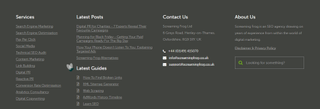
Screaming Frog has a well-structured support system to assist you in resolving any type of technical issue. You can start by utilizing self-support resources. These guides include the latest version of the SEO Spider, a starter guide, FAQs, and a user guide, available for addressing common problems and queries.
For more complex or specific issues, Screaming Frog has direct technical support. For this, you are advised to save your log files through the app ('Help > Debug > Save logs') and include detailed information about the site, the issue at hand, and any relevant screenshots or videos. This can be done by emailing support@screamingfrog.co.uk or using the 'open a support ticket' option on their website. The support team at Screaming Frog is committed to responding to queries within 24 hours during standard business hours. This dual approach to support paired with self-help resources reflects Screaming Frog's dedication to user satisfaction and problem resolution.
Screaming Frog: The competition
Priced at £149 annually, it is a cost-effective option compared to other tools. For example, SerpStat starts at $69/month, which totals over $800 annually, and it makes Screaming Frog a more budget-friendly choice. However, Screaming Frong’s alternate competitor, Yoast SEO is known for its user-friendly interface and integration with WordPress and it might turn out to be a better option for those who prioritize ease of use and immediate feedback.
However, Screaming Frog's manual configuration for tracking changes in page rankings may be a drawback for some users. This is because tools like Ahrefs offer automated alerts. It starts at $99/month and provides a range of tools in a user-friendly interface. Furthermore, its other competitor Semrush offers a variety of SEO, content marketing, competitor analysis, and PPC tools and starts at $119.95/month.
Screaming Frog: Final verdict
The Screaming Frog SEO Spider stands out in the market because of its thorough analysis and cost-effectiveness. It costs £149/year and provides a wide range of features for detailed SEO audits. This makes it a valuable asset for in-depth website analysis as it can crawl large sites and identify various issues like broken links, duplicate content, and security issues.
However, its technical interface may be challenging for those who prefer simpler, more automated tools. Competitors like Serpstat, Yoast SEO, Ahrefs, and Semrush deliver more user-friendly interfaces and a wider range of marketing tools. However, the cost of these tools is comparatively higher than Screaming Frog. In conclusion, Screaming Frog is ideal for you if you need detailed data and thorough site audits. Overall, it is particularly suitable for individuals, small teams, and agencies who want multi-functional SEO tools without a high investment.
- We've also featured the best content marketing tools.
Pawan Singh is a tech writer at TechRadar Pro, where he contributes fresh how-to guides, product reviews, and buying guides within the tech industry. Apart from his writing duties, Pawan offers editorial assistance across various projects, ensuring content clarity and impact. Outside the world of tech, he enjoys playing basketball and going on solo trips.
